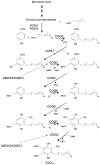Coenzyme Q and mitochondrial disease
- PMID: 20818733
- PMCID: PMC3097389
- DOI: 10.1002/ddrr.108
Coenzyme Q and mitochondrial disease
Abstract
Coenzyme Q(10) (CoQ(10)) is an essential electron carrier in the mitochondrial respiratory chain and an important antioxidant. Deficiency of CoQ(10) is a clinically and molecularly heterogeneous syndrome, which, to date, has been found to be autosomal recessive in inheritance and generally responsive to CoQ(10) supplementation. CoQ(10) deficiency has been associated with five major clinical phenotypes: (1) encephalomyopathy, (2) severe infantile multisystemic disease, (3) cerebellar ataxia, (4) isolated myopathy, and (5) nephrotic syndrome. In a few patients, pathogenic mutations have been identified in genes involved in the biosynthesis of CoQ(10) (primary CoQ(10) deficiencies) or in genes not directly related to CoQ(10) biosynthesis (secondary CoQ(10) deficiencies). Respiratory chain defects, ROS production, and apoptosis contribute to the pathogenesis of primary CoQ(10) deficiencies. In vitro and in vivo studies are necessary to further understand the pathogenesis of the disease and to develop more effective therapies.
(c) 2010 Wiley-Liss, Inc.
Figures
References
-
- Aeby A, Sznajer Y, Cave H, et al. Cardiofaciocutaneous (CFC) syndrome associated with muscular coenzyme Q10 deficiency. J Inherit Metab Dis. 2007;30:827. - PubMed
-
- Artuch R, Brea-Calvo G, Briones P, et al. Cerebellar ataxia with coenzyme Q(10) deficiency: diagnosis and follow-up after coenzyme Q(10) supplementation. J Neurol Sci. 2006;246:153–158. - PubMed
-
- Aure K, Benoist JF, Ogier de Baulny H, et al. Progression despite replacement of a myopathic form of coenzyme Q10 defect. Neurology. 2004;63:727–729. - PubMed
-
- Bentinger M, Brismar K, Dallner G. The antioxidant role of coenzyme Q. Mitochondrion. 2007;7 (Suppl):S41–S50. - PubMed
-
- Bentinger M, Dallner G, Chojnacki T, et al. Distribution and breakdown of labeled coenzyme Q10 in rat. Free Radic Biol Med. 2003;34:563–575. - PubMed
Publication types
MeSH terms
Substances
Grants and funding
LinkOut - more resources
Full Text Sources
Other Literature Sources
Medical


